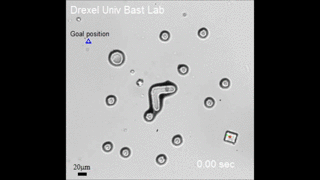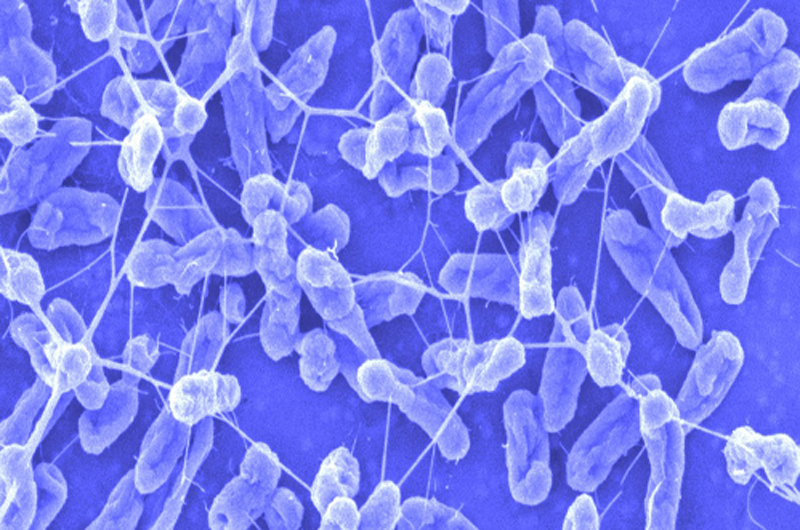Electrical control of bacteria-powered microrobots
March 15, 2016

Electric fields help microscopic bacteria-powered robots detect obstacles in their environment and navigate around them to get to their destination. (credit: Drexel University)
Drexel University engineers have developed a method for using electric fields to help microscopic bacteria-powered robots detect obstacles in their environment and navigate around them. Uses include delivering medication, manipulating stem cells to direct their growth, or building a microstructure, for example.
The method is a follow-up to a 2014 report that presented a way to use the flagellated bacteria Serratia marcescens and an electric field to make a microrobot mobile. These bacteria possess a negative charge, which means they can be manipulated, in this case, with two perpendicular electric fields that turn the fluid into an electrified grid.

Serratia marcescens bacteria are the perfect candidate for use in driving microrobots because they have a natural negative charge, which means they can be manipulated with an electric field, and their flagella reduce friction while helping the robot move in a fluid environment. (credit: Drexel University)
By running a series of tests using charged particles, the team realized how the electric field changed when it encountered insulator objects. “The electric field was distorted near the corners of the obstacle,” the authors write. “Particles that passed by the first corner of the obstacles also had affected trajectories even though they had a clear space ahead to pass; this is due to the distorted electric field.”
They used this deformation in the field as input data for their steering algorithm; the robots are using electric fields both as a mode of transportation and as a means of navigation. The algorithm also uses image-tracking from a microscope-mounted camera to locate the initial starting point of the robot and its ultimate destination.
“With this level of control and input from the environment we can program the microrobot to make a series of value judgments during its journey that affect its path,” said MinJun Kim, PhD, a professor in the College of Engineering and director of Drexel’s Biological Actuation, Sensing & Transport (BAST) Lab. “If, for instance, we want the robot to avoid as many obstacles as possible, regardless of the distance traveled. Or we could set it to take the most direct, shortest route to the destination — even if it’s through the obstacles.”
The next step for Kim’s lab is to develop a system consisting of multiple bacteria-powered microrobots that can manipulate multiple live cells in vitro.
The research was recently published in IEEE Transactions on Robotics.
Abstract of Electric Field Control of Bacteria-Powered Microrobots Using a Static Obstacle Avoidance Algorithm
A bacteria-powered microrobot (BPM) is a hybrid robotic system consisting of an SU-8 microstructure with active surfaces or bacterial carpets, in which massive arrays of biomolecular flagellar motors work cooperatively. This paper suggests an obstacle-avoidance method based on a BPM’s response to electric fields. The negatively charged bacteria enable the BPM to follow electric fields. In our previous demonstration of the single BPM controllability, we observed a vast change in the control dynamics when obstructions distorted the applied electric field and affected BPM steering and control. In this paper, we demonstrate an obstacle avoidance method that takes the electric field distortion into account to navigate a BPM through multiple static obstacles in real time. We used an artificial potential field and configuration space in our algorithm to generate an objective function for the electric field distortion and collision around/with obstacles, respectively. In addition, finite-element modeling through COMSOL Multiphysics engineering software was used to simulate charged-particle trajectories in a distorted electric field. Finally, we describe the feasibility of our proposed obstacle avoidance approach through experiments and compared these data with simulation results.